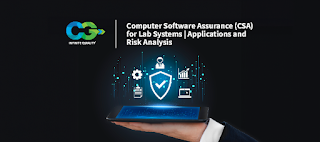FDA Computer Software Assurance | Compliance Group
Computer software assurance validation is a crucial process that ensures the reliability, functionality, and compliance of software used in regulated industries, particularly in sectors like pharmaceuticals, biotechnology, and medical devices. Validation is a systematic and documented approach to confirm that a software system or application meets its predefined specifications and fulfils its intended purpose. In the context of regulatory compliance, such as adhering to 21 CFR Part 11 for FDA-regulated industries, software validation is essential to demonstrate that electronic records and signatures generated by the software are trustworthy.
Here are key components of computer software assurance validation:
1. Validation Planning:
- Develop a
comprehensive validation plan outlining the scope, objectives, and approach for
validating the software. This plan should include details about the testing
strategy, resources, and validation activities.
2. User Requirements Specification (URS):
- Clearly define
user requirements for the software. This involves documenting the
functionalities and features that the software must have to meet regulatory and
business needs.
3. Risk Assessment:
- Conduct a risk
assessment to identify potential risks associated with the software, especially
those related to data integrity, security, and regulatory compliance.
4. Installation Qualification (IQ):
- Verify that the
software is installed correctly, confirming that hardware and software
components are in place and meet specified requirements.
5. Operational Qualification (OQ):
- Test and document
the functional aspects of the software to ensure that it operates according to
predefined specifications. This includes testing various scenarios to validate
the software's performance.
6. Performance Qualification (PQ):
- Demonstrate that
the software performs effectively and consistently under normal operating
conditions. This phase may involve simulated or real-world testing to validate
the software's reliability.
7. Traceability Matrix:
- Develop a
traceability matrix linking each requirement to the corresponding validation
activities and test results. This matrix ensures that all requirements are
addressed during the validation process.
8. Change Control:
- Implement a
change control process to manage any modifications or updates to the software.
Changes should be documented, reviewed, and validated to maintain the integrity
of the system.
9. Documentation:
- Maintain thorough
documentation throughout the validation process, including protocols, test
results, and validation reports. This documentation serves as an evidence of
compliance during audits.
10. Training:
- Provide training
to personnel using or managing the software. Ensure they understand the
validated state of the software and are aware of proper usage procedures.
11. Periodic Reviews and Revalidation:
- Conduct periodic reviews of the software to ensure continued compliance with regulatory requirements. Revalidation may be necessary following significant software updates or changes.
By following a structured validation process, organizations
can instil confidence in the reliability of their computer software, meet
regulatory requirements, and mitigate the risk of non-compliance. It's a
proactive approach to quality assurance ensuring the integrity and security of
electronic records and contributing to overall product and process quality.
Citations:
FDA Computer Software Assurance |Computer System Validation FDA (complianceg.com)
CSA/CSV Principles for Cybersecurity Industries (complianceg.com)

Comments
Post a Comment